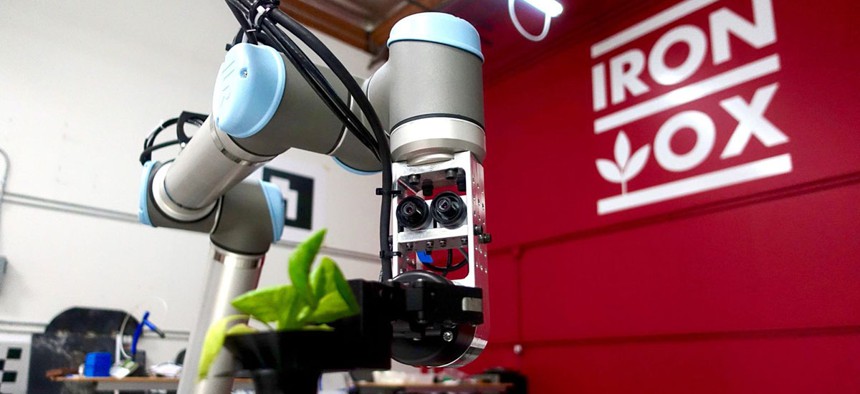Your Next Head of Lettuce, Grown By a Robot

Dave Gershgorn/Quartz
The farm meets the startup.
You could drive past and never see the only farm in San Carlos, California. The tiny city of 30,000 that sits between San Francisco and Silicon Valley has all the charms of suburbia—sprawling office parks and single-story homes—but doesn’t seem a likely suspect for agriculture.
The farm, run by startup Iron Ox, is nestled between three stonemasons and a plumber in a nondescript office park building; there’s no greenhouse, no rows of freshly-tilled soil, or tractor parked outside. Only peeking in the large bay door reveals the building’s tenants: a few hundred plants and two brightly-colored robot farmers.
Iron Ox looks a lot like a tech company. One of its co-founder is an ex-Google engineer and it raised $1.5 million in pre-seed venture capital from Y Combinator, Pathbreaker, and Cherubic Ventures in April 2016. Instead of fake food, or plant-based meat meals, or even a food delivery service tethered to an app, Iron Ox is reinventing farming, raising real, not faux, food. Think hydroponically raised lettuce and basil, like what you’d get at an ordinary farmers market.
Iron Ox plans to build a network of autonomous, robot-run greenhouses near major US cities, complete with a fleet of trucks to ensure same-day delivery. Traditional outdoor farms don’t mesh with suburban sprawl, but the planned square-acre greenhouses have a small footprint that can easily fit into dense urban or suburban areas. The robots plant, raise, and harvest the crops.

Pod lettuce
Co-founder and CEO Brandon Alexander, who worked on Google’s Project Wing, figuring out how to make multiple robots work together, says it takes just three or four months to set up one of its farms. Plants take six weeks to mature. One of these modular, square-acre farms could provide the same yearly yield as 30 acres of traditional farmland, Alexander says.
“We want to have the most efficient farm out there,” says Alexander. “In some ways this is just the natural evolution of [farming].” Growing up, Alexander spent summers working on his grandfather’s peanut, potato, and cotton farm that straddles Texas and Oklahoma. He’s seen his grandfather adopt self-guided tractors and other new technologies, giving the ability to scale the family farm from 40 to 5,000 acres in one generation.
While raising crops has evolved from the time of small family farms, it’s still inefficient, Alexander says. Vegetables waste a large portion of their shelf lives traveling 2000 miles to get from farm to store. In addition, the pool of labor for existing centralized farms is aging and diminishing. The average US farmer is 55 years old, and the average crop worker is 33. “There’s just not enough labor to go around,” Alexander says.
Iron Ox isn’t the only company trying to revolutionize food production. Plenty, another Bay area startup, recently received $200 million from the Softbank Vision fund with a similar mission of distributed farms near metropolitan areas. Plenty’s buzzword isn’t automation, but vertical farming: growing crops up walls to save space. AeroFarms wants to disrupt hydroponics with nutrient-filled mist. Freight Farms will grow crops in shipping containers.
The robots
Iron Ox plans to use three robots powered by artificial intelligence to work each square-acre of greenhouse. Two robots, without official names but referred to as transporters, will lift and ferry trays of plants over to the third robot, a robotic arm. The robotic arm will plant seeds, cycle juvenile plants into larger growing plots, image the plants to check for disease, and harvest the crop. Iron Ox plans to grow leafy greens like the lettuce and basil varieties it is testing now. Large-field crops like corn aren’t on the roadmap.
Iron Ox is using a hydroponic system called deep water culture; the plants, seated in plastic cones, float on a raft in a tray of water, their roots submerged in nutrient-rich water.
These trays are the key to Iron Ox’s indoor farm; while many deep water culture systems are built around large, stationary pools of water, these trays allow the plants to be moved to and from the robotic arm. The company developing the three components—robotic arm movement, transporter robot, and automated hydroponic system—separately. Humans now do the work slated for the robots, but the pre-robot farming provides a valuable runway of data for Iron Ox about optimal growing conditions.

Half a dozen data points are collected from each water tray per second, plus air temperature and quality, ambient light, humidity. The brains of the system are in the robotic arm. If it knows certain plants need more space, the transporter can be summoned to collect them for transplanting. If it’s time for harvest, the trays come to the arm.
The arm, which stands between two trays, moves with serpentine ease only occasionally interrupted by a mechanical lurch. As I watch, it’s controlled by CTO Jon Binney, but can be set to autonomously shuffle plants around from tray to tray. The goal is to only have one robot arm per acre of greenhouse, able to switch out its end effector, or hand, for specialized tools based on the task. Universal Robots is the arm’s manufacturer, but it runs custom code for motion planning. The stereoscopic cameras used to image the produce are installed and integrated by Iron Ox, and the end effectors used to inject and transplant are built custom-built by the company as well.
The transporter’s job is to hulk over a tray of plants, tuck the tray into its belly, and carefully transport it to a space next to the arm. It glides around the warehouse with a precise, mechanical grace, seemingly able to drift in any direction on its Mecanum wheels. These specialized wheels mean the trays can be just inches apart on the entirety of the greenhouse floor, since the transporter doesn’t need space to turn.

The process
The plants start as seeds, which are injected by the robotic arm into small, foam-like cubes seated in a plastic cone. The plastic cone protects the base of the plant from the robotic arm’s grippers, which giving each plant a standardized place to grip the plant while moving it around.
When the seeds have sprouted and grown for about two weeks, they are brought to the arm by the transporter. The robotic arm then picks up the plants and transplants them to a tray with more room between each plant. Each tray is outfitted with augmented reality tags (that allow the arm to recognize which tray it’s working with, and the bounds of where it can and can’t put plants.)

Two weeks later, the transplant process occurs again, and then again two weeks after that. Each time a plant is moved, two cameras on the arm build a 3D model of it, which is analyzed to check for disease and to ensure it’s growing normally. After the plant is fully grown, the arm pulls it—roots and all—from its plastic cone, and places it in a plastic clamshell container to be shipped.
The company has yet to launch its first fully-functioning greenhouse, and it currently donates its hydroponically-grown produce at a local San Carlos food bank in addition to supplying the company salad bar. IronOx wants to build the first greenhouse by the end of 2017, sell to local chefs in the Bay Area, and then scale to grocery stores in early 2018.
NEXT STORY: Octopus-Inspired Material Can Change Its Texture





